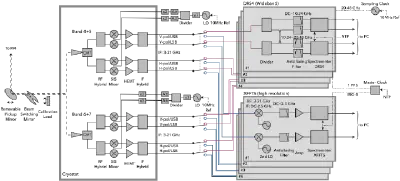Receiver
Specifications summary (as of 2022 June)
| General | |
|---|---|
| Number of bands | 2 (Band 4+5 and 6+7) |
| Number of beams per band | 1 |
| Number of polarizations per band | 2 |
| Number of sidebands per band | 2 |
| Spec | Low Frequency Band | High Frequency Band |
|---|---|---|
| Radio frequency | 120−210 GHz | 210−350 GHz |
| Intermediate frequency | 4-20.48 GHz | 4-20.48 GHz |
| Receiver noise temperature | 45 K | 75 K |
System overview
FINER consists of low- and high-frequency band SIS receivers, each of which covers the ALMA’s Band 4+5 (120-210 GHz) and Band 6+7 (210-350 GHz), respectively. The front-end receivers are followed by the back-end spectrometers with wide-band and high-dispersion modes.

Optics
A dual-polarization single beam from each receiver band is coupled with the LMT’s optics. The FINER warm optics is planed to have a beam-switching mechanism which allows a quick (~1 Hz) position switching for atmospheric removal. The spatial resolution (i.e. PSF size) is 7 arcsec X (frequency/200 GHz)^-1, depending on observing frequency.
Front-end receiver
The front-end receiver exploits the high critical current density SIS mixer technology (Kojima et al. 2017, 2020) for ALMA 2 (wideband sensitivity upgrade, WSU), which allows us to have a wide instantaneous frequency coverage.
Back-end spectrometer
FINER has two sets of digital spectrometers with different spectral resolutions and bandwidths.
- Wide-band spectrometers (DRS4, ELECS Inc.). Analog IF input is digitized by a set of 3-bit 20.48 GSa/s analog-to-digital converters (ADCs), each of which offers a 10.24 GHz bandwidth with a 20 MHz spectral resolution.
- High-resolution spectrometers (XFFTS, RPG). spectroscopy is offered by the array of 2.5-GHz digital spectrometers, XFFTS (RPG).
Data analysis software & Data format
Technical document
| Document | Version | Download |
|---|---|---|
| Proposal | 1-May-2023 | (in prep.) |
| Overview | 1-May-2023 | (in prep.) |